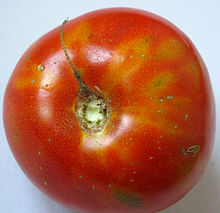Tomato spotted wilt virus
Bean necrotic mosaic virus
Capsicum chlorosis virus
Groundnut bud necrosis virus
Groundnut ringspot virus
Groundnut yellow spot virus
Impatiens necrotic spot virus
Iris yellow spot virus
Melon yellow spot virus
Peanut bud necrosis virus
Peanut yellow spot virus
Soybean vein necrosis-associated virus
Tomato chlorotic spot virus
Tomato necrotic ringspot virus
Tomato spotted wilt virus
Tomato yellow ring virus
Tomato zonate spot virus
Watermelon bud necrosis virus
Watermelon silver mottle virus
Zucchini lethal chlorosis virus
The tospoviruses are a genus (Tospovirus) of negative RNA virus found within the family Bunyaviridae. They are the sole group of plant infecting viruses in this family, as all other described members of the Bunyaviridae infect animals. The genus takes its name from the discovery of tomato spotted wilt virus (TSWV) in Australia in 1915. It remained the only member of the family until the early 1990s when genetic characterisation of viruses discovered in plants became more common. There are now at least twenty viral species in the family with more being recorded and described on a relatively regular basis. Together, these viruses have been documented infecting over eight hundred different plant species from 82 different families.
This virus has a single stranded RNA genome with negative polarity, therefore it is classified as a Class V virus ((-)ssRNA viruses). The structure of the genome resembles that of the genus Phlebovirus. The genome is linear and is 17.2 kb in size. It is segmented into three segments termed S (2.9kb), M (5.4kb) and L (8.9kb). The M and S RNA segments encode for proteins in an ambisense orientation.
...
Wikipedia

